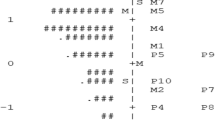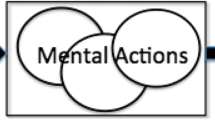Abstract
This study investigated how children tackled a task on division by fractions, and how they formulated numerical algorithms from their strategies. The task assigned to the students was to find the length of a rectangle given its area and width. The investigation was carried out as follows: First, the strategies invented by eight 10- or 11-year-old students, all identified as capable and having positive attitudes towards mathematics, were categorised. Second, the formulation of numerical algorithms from the strategies constructed by nine students with similar abilities and attitudes towards mathematics was investigated. The participants developed three types of strategies (making the width equal to 1, making the area equal to 1, and changing both area and width to natural numbers) and showed the possibility of formulating numerical algorithms for division by fractions referring to their strategies.















Similar content being viewed by others
References
Behr, M., & Post, T. (1992). Teaching rational number and decimal concepts. In T. R. Post (Ed.), Teaching mathematics in grades K-8: Research-based methods (pp. 201–248). Boston: Allyn and Bacon.
Bezuk, N. S., & Armstrong, B. E. (1993). Understanding division of fractions. The Mathematics Teacher, 86, 43–46.
Boero, P., Ferrari, P. L., & Ferrero, E. (1989). Division problems: meanings and procedures in the transition to a written algorithm. For the Learning of Mathematics, 9(3), 17–25.
Brendefur, J. L., & Pitingoro, R. C. (1998). Dividing fractions by using the ratio table. In L. J. Morrow & M. J. Kenney (Eds.), The teaching and learning of algorithms in school mathematics (pp. 204–207). Reston: National Council of Teachers of Mathematics.
Bulgar, S. (2003). Children’s sense-making of division of fractions. The Journal of Mathematical Behavior, 22, 319–334. doi:10.1016/S0732-3123(03)00024-5.
Fischbein, E., Deri, M., Nello, M. S., & Marino, M. S. (1985). The role of implicit models in solving verbal problems in multiplication and division. Journal for Research in Mathematics Education, 16, 3–17. doi:10.2307/748969.
Flores, A., Turner, E. E., & Bachman, R. C. (2005). Posing problems to develop conceptual understanding: two teachers make sense of division of fractions. Teaching Children Mathematics, 12(3), 117–121.
Freudenthal, H. (1973). Mathematics as an educational task. Dordrecht: Reidel.
Graeber, A. O., & Tirosh, D. (1990). Insights fourth and fifth graders bring to multiplication and division with decimals. Educational Studies in Mathematics, 21, 565–588. doi:10.1007/BF00315945.
Gregg, J., & Gregg, D. U. (2007). Measurement and fair-sharing models for dividing fractions. Mathematics Teacher in the Middle School, 12, 490–496.
Hatfield, M. M., Edwards, N. T., & Bitter, G. G. (1997). Mathematics methods for the elementary and middle school teachers (3rd ed.). Massachusetts: Allyn and Bacon.
Huinker, D. (1998). Letting fraction algorithms emerge through problem solving. In L. J. Morrow & M. J. Kenney (Eds.), The teaching and learning of algorithms in school mathematics (pp. 170–182). Reston: National Council of Teachers of Mathematics.
Kamii, C., & Warrington, M. A. (1999). Teaching fractions fostering children’s own reasoning. In L. V. Stiff & F. R. Curcio (Eds.), Developing mathematical reasoning in grades k-12 (pp. 82–92). Reston: National Council of Teachers of Mathematics.
Lee, Y. R. (2001). Jido Naiyongui Haiksim Gwaje 99 (The 99 core tasks of elementary school) mathematics. Seoul: Kyungmoon.
Lubinski, C. A., Thomason, R., & Fox, T. (1998). Learning to make sense of division of fractions: One K-8 preservice teacher’s perspective. School Science and Mathematics, 98(5), 247–253.
Ma, L. (1999). Knowing and teaching elementary school mathematics. Mahwah: Lawrence Erlbaum.
Musser, G. L., & Burger, W. F. (1988). Mathematics for elementary teachers. New York: Macmillian.
National Council of Teachers of Mathematics. (2000). Principles and standards for school mathematics. Reston: National Council of Teachers of Mathematics.
Okazaki, M., & Koyama, M. (2005). Characteristics of 5th graders’ logical development through learning division with decimals. Educational Studies in Mathematics, 60, 217–251. doi:10.1007/s10649-005-8123-0.
Ott, J. M., Snook, D. L., & Gibson, D. L. (1991). ‘Understanding partitive division of fractions. The Arithmetic Teacher, 39(2), 7–11.
Pagni, D. (1998). Giving meaning to multiplication and division of fractions. Australian Mathematics Teacher, 54(4), 11–13.
Perlwitz, M. D. (2004). Two students’ constructed strategies to divide fractions. Mathematics Teacher in the Middle School, 10, 122–126.
Perlwitz, M. D. (2005). Dividing fractions: Reconciling self-generated solutions with algorithmic answers. Mathematics Teacher in the Middle School, 10, 278–283.
Pirie, S. E. B. (1988). Understanding: Instrumental, relational, intuitive, constructed, formalised…? How can we know? For the Learning of Mathematics, 8(3), 2–6.
Sharp, J. (1998). A constructed algorithm for the division of fractions. In L. J. Morrow & M. J. Kenney (Eds.), The teaching and learning of algorithms in school mathematics (pp. 198–203). Reston: National Council of Teachers of Mathematics.
Sharp, J., & Adams, B. (2002). Children’s constructions of knowledge for fraction division after solving realistic problems. The Journal of Educational Research, 95, 333–347.
Shimizu, Y. (1996). High achievement versus rigidity: Japanese students’ thinking on division of fractions. Paper presented at the China–Japan–U.S. seminar on mathematics education, ERIC document reproduction service No. ED395776.
Siebert, I. (2002). Connecting informal thinking and algorithms: The case of division of fractions. In B. Litwiller & G. Bright (Eds.), Making sense of fractions, ratios, and proportions (pp. 247–256). Reston: National Council of Teachers of Mathematics.
Sinicrope, R., Mick, H. W., & Kolb, J. R. (2002). Interpretations of fraction division. In B. Litwiller & G. Bright (Eds.), Making sense of fractions, ratios, and proportions (pp. 153–161). Reston: National Council of Teachers of Mathematics.
Thompson, C. (1979). Teaching division by fractions with understanding. The Arithmetic Teacher, 26, 24–27.
Thompson, P. W., & Saldanha, L. A. (2003). Fractions and multiplicative reasoning. In J. Kilpatrick, W. G. Martin & D. Schifter (Eds.), A research companion to principles and standards for school mathematics (pp. 95–113). Reston: National Council of Teachers of Mathematics.
Tirosh, D. (2000). Enhancing prospective teachers’ knowledge of children’s conceptions: The case of division of fractions. Journal for Research in Mathematics Education, 31, 5–25. doi:10.2307/749817.
Tirosh, D., & Graeber, A. O. (1989). Preservice elementary teachers’ explicit beliefs about multiplication and division. Educational Studies in Mathematics, 20, 79–96. doi:10.1007/BF00356042.
Van de Walle, J. A. (1998). Elementary and middle school mathematics: Teaching developmentally (3rd ed.). New York: Addison Wesley Longman.
Warrington, M. A. (1997). How children think about division with fractions. Mathematics Teacher in the Middle School, 2, 390–394.
Author information
Authors and Affiliations
Corresponding author
Rights and permissions
About this article
Cite this article
Yim, J. Children’s strategies for division by fractions in the context of the area of a rectangle. Educ Stud Math 73, 105–120 (2010). https://doi.org/10.1007/s10649-009-9206-0
Received:
Accepted:
Published:
Issue Date:
DOI: https://doi.org/10.1007/s10649-009-9206-0




